This week’s post is sponsored by Showers Pass, who reminds you to drop by their big Warehouse Sale this Saturday from 9am to 1pm.
Welcome to the week.
Please take time today to honor Indigenous Peoples Day and think about the people who first settled — and continue to live — on the land your ride through (see the map above).
Green Google Maps: The company has announced that this week their service will show the travel mode option with the lowest estimated carbon emissions and will even default to the cleanest option if/when trip times are comparable. This just underscores the need for Google to update its algorithm to account for the faster speed of e-bikes!
Gavin’s gaffe: California’s Governor chose to veto bills that would have decriminalized jaywalking and allowed bicycle riders to “slow-and-go” at stop signs.
Bike sales remain strong: According to NPD Group, e-bikes grew by “a whopping 240%” during the 12-month period between July 2020 and July 2021 in just one of many bright spots in demand for bikes and bike accessories.
Troubled Texan teens: WTH is wrong with Texas teens and using cars as weapons? Just a few weeks after a boy seemed to purposely run over a group of bike riders, another Texas teen fled from police after doing doughnuts then hit and killed three valets.
More on that coal-rolling Texas teen: This bicycle law firm published a scathing article that lays bare the anti-bike bias in the city of Waller, Texas, and shows that the victims in the case are likely to continue to face unfair treatment from law enforcement, the media, and the legal system.
Poo-pooing plastic: The Mayor of Jersey City made waves last week when he announced his intention to replace plastic wands with concrete jersey barriers in order to provide more “substantial protection” for bike lanes. Your move Ted Wheeler!
Advertisement
Cheaper e-bikes: A cool collab in Corvallis sees a power company, economic development officials, and bike shop owners converge to put a $60,000 grant for e-bike subsides to work.
Honk if you love me: Great news! According to a recent survey, it appears that drivers in both Seattle and Portland are starting to like the idea of courtesy honks more, a thing that’s common in other countries and that, in my opinion, could be a boon for bicycling safety and culture. Communication between drivers and bikers could be greatly improved if people shed their reflexive anger to all types of honking.
The Biden Effect: I had no idea Trump had the White House Capital Bikeshare station removed, but I’m very pleased to hear that Biden has brought it back.
How’d they do it?: Fremont, California is a rare city where a Vision Zero proclamation seems to have actually led to tangible and significant progress in reducing crashes and a massive shift in what streets look and feel like.
What people want: Here’s one way to do it: “A citizens’ initiative calling for a ban on private car use in central Berlin would create the largest car-free urban area in the world.”
Death by 1000 shortcuts: According to this KOIN article, PBOT is struggling to stem the flow of shortcutting drivers who use Waze and Google Maps to fly through neighborhood streets just to save a few minutes.
— Jonathan Maus: (503) 706-8804, @jonathan_maus on Twitter and jonathan@bikeportland.org
— Get our headlines delivered to your inbox.
— Support this independent community media outlet with a one-time contribution or monthly subscription.


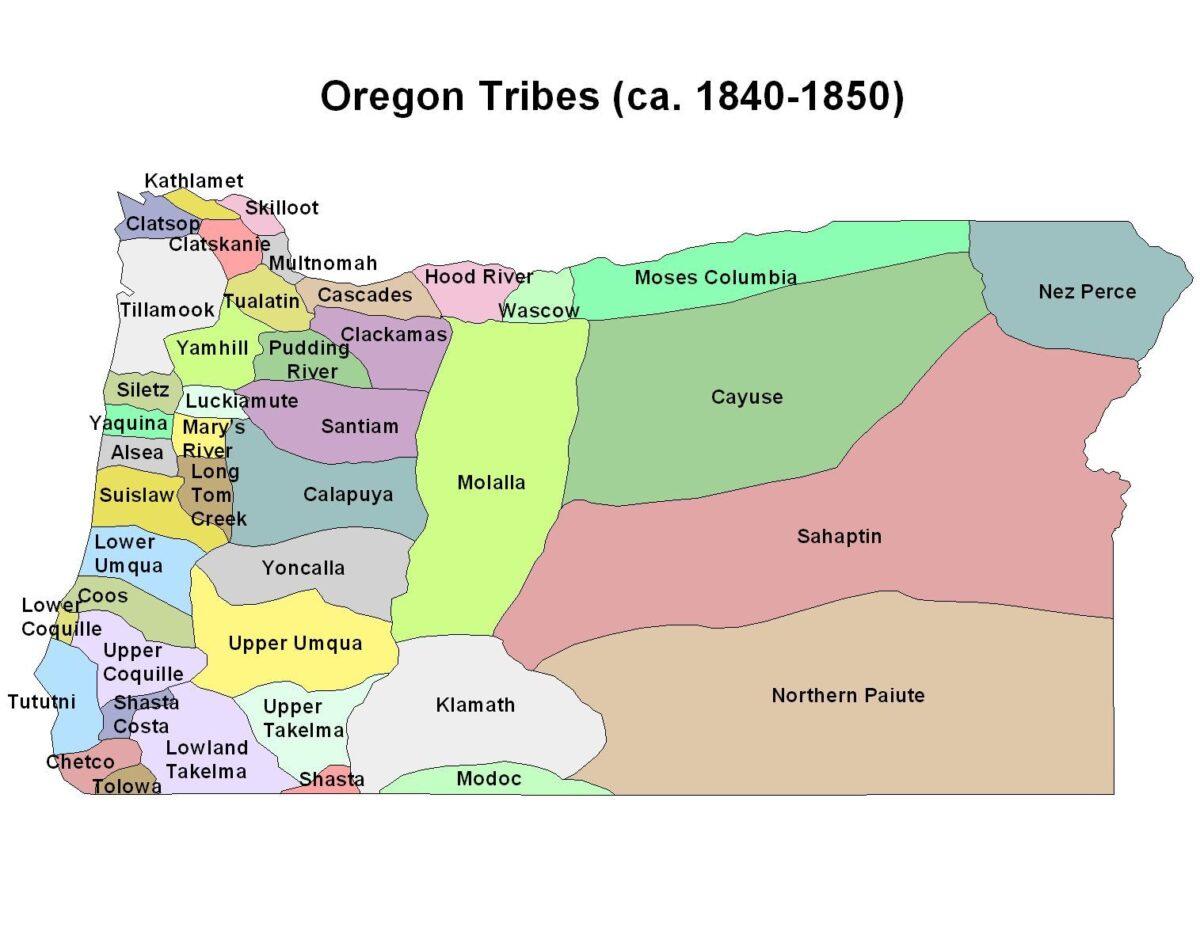
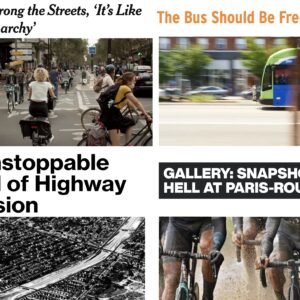
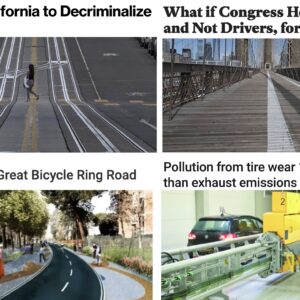
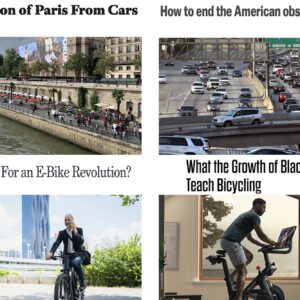
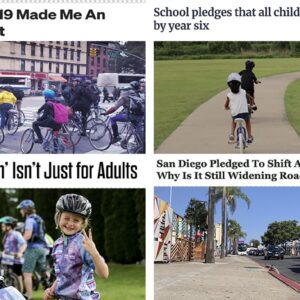
Thanks for reading.
BikePortland has served this community with independent community journalism since 2005. We rely on subscriptions from readers like you to survive. Your financial support is vital in keeping this valuable resource alive and well.
Please subscribe today to strengthen and expand our work.
Thanks to smartphones, every neighborhood street is a through street. I can’t be the only, much less first person who’s been saying this on BikePortland for years.
Who knows, we could even manage the traffic on collectors and arteries if we put it where it belongs.
I think city streets should be designed like a Celtic knot, with the exception of main routes. In other words, make it so intolerable to use side streets for anything other than local access that motorists (only, not cyclists) are forced to use the main roads.
I’ve always thought that is a huge missing component of a lot of suburb communities. If you linked a lot of the cul-de-sac or not through street neighborhoods together with short paths you could make some awesome greenways for very little effort.
Yes, that would make the ‘burbs better. This could be done in the residential areas of North, North East, and South East PDX as well. Example, consider Burnside and Ankeny; motorist will blaze down Ankeny if Burnside is congested.
Solution? Make the cross streets feed back onto Burnside. Two left or right turns, depending on the cross street, and you’re back at Burnside. The businesses on Ankeny would still have access, but the Greenway would be less disturbed. It already exists in one spot, at SE 15th, where there is a left turn only – from the perspective of coming off of Burnside.
It’s how East Portland’s street network was designed by Multnomah County before the city annexed it – it was considered “best practices” in the 1960s and 1970s. All traffic is on the main arterial stroads next to the high density apartments, with businesses at major corners of every superblock; at the center of each superblock was a school and/or park; and in between was various densities of suburban development on a confusing maze of streets and cul-de-sacs. Great in theory, but horrible if you have to live there.
At the end of the day, is it worse to have speed demons racing past your home or mildly difficult to get to your drive way? I know what I’d say, keep my streets safe so I can use them in peace.
I don’t think “cell phones” are the root cause of this, but I know what you mean..
It seems to be more that the routing algorithm for map/directions applications prioritizes “shortest time” instead of something more complicated like “most appropriate/efficient/etc.”
We all know that roads are designed with a carrying capacity and flow in mind, sometimes they aren’t always the “fastest” but they are the most appropriate for a given trip.
It’s a harder problem to solve to create a program to give directions that way, and the incentive to the app makers is profit, so it isn’t surprising “shortest” is designed for instead.. It’s easier to implement and people are convinced they prefer it. I think people maybe don’t realize how stressful driving is and they’d find its worth it to take a more appropriate route that is 10min longer.
It’s not an impossible problem to solve and well within our ability. Maybe, if the city can change the status of certain streets so that they are not categorized as a viable option in the app, the apps will adjust to avoid them.
Granted, congestion, suburban sprawl, and lack of alternatives for transport make this proposition of “efficiency focused algorithm” muddy real quick.. So who knows.. It’s also a bit BS in my mind to keep putting all our hopes in these tech companies and market forces to save us from their own creations.. but that’s neither here nor there..
Things were much better before directional apps on cell phones. Back in the day, very few people were good at reading paper maps so they tended to stick with known major routes. No way would most people in 1987 jump off broadway and attempt a diagonal trip through Irvington and NE Portland to get to the airport instead of going all the way to 82nd. Easy navigation of the local streets of Portland was only possible with lots of experience. I for one am looking forward to the day when the next Carrington event wipes out the cell phone network for good.
‘Back in the day’ has different meanings to different people. I started being a car passenger in 1947 and a driver in 1963. We were all very adept at reading folding maps, finding interesting routes, off the beaten track, and experiencing America at a slower pace.
What’s a paper map? Asking for a 12-year old.
I too remember those good old days. Looking up stuff in the yellow pages. Getting airline tickets through travel agents. Having to get hotel reservations through tourist info centers (and being discriminated against by those very same staff – crappy or no places to stay if they didn’t like your face/race/gender/clothes.) The clouds of second-hand cigarette smoke everywhere. Bicycle brakes that didn’t actually stop. Carrying lots of cash and travelers checks (credit cards for us poor schmucks were still rare before 1990, ATMs came in the 80s). Leisure Suits. Disco.
Yup. The pre-Disc Brake Era.
So you mean it was easier getting around Portland when the population was half of what it is today?!? I am flabbergasted.
The navigation technologies just point out what is a fact: that neighborhood streets are often faster than through streets. PBOT needs to work on changing that by putting barriers in place that make neighborhood streets slower, and they should do it fast and comprehensive, instead the current slow, piece-meal approach. Bike boulevards especially should have barriers every 6 blocks or so that block vehicle traffic. By blaming Waze, PBOT is adjudicating its responsibility to create an infrastructure that supports the intended use of streets.
Agreed. And this can be shown when actual diverters are put in — for instance when the substantial ones at SE Clinton/17th and 32nd happened, Google/Waze/etc. stopped directing drivers down that street.
Neighborhoods across the world have had to deal with cut-through traffic in the last 15 years — see for instance the articles on the unfortunate New Jersey towns that are near approaches to the NYC tunnels and bridges. But put up some barriers and make some roads one-way and, like magic, direction apps will no longer send drivers down that street. It’s not a mystery how to solve this.
Last time I went to SF, I was blown away (hehe) by all the errant honking. It felt like a constant, like barking dogs or howling kookaburras. I feel that honking is a very low form of communication.
Bicycle bells on the other hand, not so much. I’ll ring my bell at every stranger on a bike as I ride through the city. It thrills me when the other cyclist(s) ring back! But to me, horns are something motorists use out of anger. At each other and at ped / bikes.
Seems I once read a law about use of horns in Oregon? Rather limited by the ORS’s. But that could have been somewhere else just as easily….regardless, ‘courtesy’, was not included.
See (1)(b):
ORS 815.225
Violation of use limits on sound equipment
(1) A person commits the offense of violation of use limits on sound equipment if the person does any of the following:
(a) Uses upon a vehicle, any bell, siren, compression or exhaust whistle.
(b) Uses a horn otherwise than as a reasonable warning or makes any unnecessary or unreasonably loud or harsh sound by means of a horn or other warning device.
(3) The offense described in this section, violation of use limits on sound equipment, is a Class C traffic violation. [1983 c.338 §491]
Per TheGoogle:
Is Honking Illegal in Oregon?
The ordinance restricts all horn honking for any purpose at any time except as a warning. For example, it is broad enough to make honking unlawful if a motorist honked his horn as a friendly greeting to a bystander as he drives by a residence or any other circumstance when honking is used as a form of communication.
Too bad we live in a modern day Deadwood.
IMO, car/truck horns are just way too loud to ever be an acceptable way to communicate with someone who not in another car/truck. Even a friendly toot feels abrasive and intrusive. A car horn is designed to startle and command attention and should never, ever be used for anything other than as a warning when communicating with a person outside a car/tuck
Since when is more honking “great news”? That’s one of the things I absolutely loved about Portland when I moved here from Chicago in the early 2000s. People don’t honk. Chicago is riddled with aggressive impatient honking. Some of it for a reason (if the first person in the left-turn lane doesn’t go right away, you will never leave this left turn lane…ever), some of it simply for reasons of impatience, poor character, unkindness, and constant negativity, as if big-city driving needed more of that. As far as bikes go, I’ve learned that my intention doesn’t translate into the sound of the horn. Long ago, on my 1980 Honda Civic, I could coax a kind of cheery, chirpy clipped beep out of it depending on the way I made my hand bounce off the horn rather than pressing it. My more modern car doesn’t do that. It only yells. It can yell for a very short period, but it’s still yelling. On a bike, horns are scary, threatening. They should be used sparingly. More honking is not “great news.” It’s awful. People can leave their awful East Coast car culture where they found it.
Hey Matt,
In a perfect world, no honking would be ideal. But cars have horns and I’d much rather live a place where we could use them to communicate courteously. But you make a good point about current horns not being technically able to make “nice” sounds or be modulated at all. (I hate bike bells that can’t be toned down too.) To that point, I’ve had a dream for a long time that automakers would actually add “courtesy horns” or some such thing to their models. Or better yet, if we could make it a cultural trend, maybe folks would install aftermarket horns that had a lower-volume, nice sound that meant “I see you”.. “it’s all good” or something like that.
A short blip of the horn *after* a safe pass is fine, maybe with a wave too. Or even at an intersection where I can see the car and drivers face. But it’s not really necessary. But when people honk right before they pass, it is really jarring and communicates basically zero helpful information. You can hear them coming w/o a honk, and it just makes me think I’m about be killed, buzzed, or called any number of insults I’m sure we’ve all heard.
I agree with Matt, there are some things from east coast car culture, among them more excessive honking, that I can do without. The stereotype of Portland drivers as relaxed to a fault defiantly has some truth, but I find it much better than aggro honking tailgaters.
In many respects communication, beyond correctly used turn signals, hazards and brake lights is just asking for road rage. I believe in South Korea and Japan a short burst of the hazards is used as a “thank you” after passing or being let into a lane. That might be ok, but I don’t think many people here would understand it.
Some older (british?) cars have a bi-volume “town” horn and “country” horn, though I think they are loud and louder. But maybe a version of that would be a good feature to bring back. But horns are somewhat of a reflexive thing and a loud, safety horn would still need to be the default, with the “nice” horn less reflexively used, I would assume. Then you’d have some people angry at which horn you used or whatever, leading to more confusion and road rage.
I share this sentiment completely. Unfortunately, we can’t.
How about a nice, peaceful curtesy headlight flash instead?
I ride out on rural high-speed roads all the time, and I don’t mind when a big truck just ‘toots’ for a fraction of a second to let me know he is coming, although it is his responsibility to avoid me. But, today, on a 55 mph two-lane rural road, a big truck leaned on his loud horn for about 3 seconds. Huh? I was as far to the right as possible, he had plenty of room to pass. I have no idea why he chose to honk. I flipped him off, truly hoping he would pull over and I could tell him that I have the right of way, and he should shut the frick up.
Lets put that to a vote. Because, I can hear vehicles approaching without the horn and to me, a horn is an aggressive communication. Regardless of the length of the “toot”, it all means the same thing to me, “I’m a motorist, get out of the way”.
Yes, I make a conscious decision to think that. I also choose think a whole host of other bad behaviors are wrong too, such as speeding, tailgating, and rolling coal.
Do you remember the Simpson’s episode that Homer discovered guns? He was doing everything with the gun; opening beer, turning the lights on.. some tools just have one purpose.
Right? I understand the problem that is trying to be solved, but there has got to be a better way..
It is reasonable to want a way to “communicate with other road users” outside the bounds of the engrained aggressiveness of a horn..
“Smart” everything is already here.. its just a matter of time for it to permeate the culture enough that you can reasonably expect everyone to have a device.
Just pie-in-the-sky spit balling here.. but what if we all had transponders in our cars and on our bikes that allowed us to communicate more effectively.
I am not thinking like emojis and text messages, but more like the Garmin Varia rear facing radar system. I would love for the radar to alert the driver that I am now aware of their presence.
Maybe it gives them a yellow “standby” indicator light on their dash, and I could then begin preparing for an appropriate passing interaction. Once I was prepared I could hit a small button on my levers and it would change the drivers light to green, alerting them that they should now pass.
Make interacting with other road users a dialog.
Idk.. the idea most certainly breaks down at a point.. but it doesn’t seem too far fetched.. Granted.. as a culture we definitely need to address some of the infrastructural, economic, and social factors that contribute to a hostile, unsustainable, and unsafe paradigm..
So.. yea, horns.. this seems like a case of “when all you have is a hammer, everything looks like a nail.”
If a person in a car wants to communicate with me when I am on my bike, my preference is a way, or just roll the window down and say thanks (or whatever).
Well, I think the obvious thing is that they did something rather than nothing. I don’t see any mention of yard signs and cheering for good driving. Maybe PBOT just doesn’t under VZ?
We know what we need to do, PBOT just isn’t willing to do it. There’s really not much to figure out. VZ requires motorists to slow down and be “inconvenienced” and that’s just something PBOT isn’t really willing to do.
And that’s how we end up with 80 concrete beg barrels that do nothing instead of 80 traffic diverters that are evidence-based to create safe streets.
PBOT has completed a lot of improvements on our High-Crash corridors. Map here.
They’ve reduced speeds. They’ve added lighting. They’ve added crossings. They’ve pushed for automated enforcement cameras. They’re doing a lot. In fact, their evidence-based work and images are being using by Fremont, CA.
When they don’t make adequate progress, it’s mainly because the opponents who are showing up are louder than the proponents. But yes, they should do more. Folks need to keep pushing.
Give me a break, Evan.
PBOT has repeatedly refused to install much of the evidence-based infrastructure used to reduce speed in Sweden.
Raised crosswalks and pedestrian refuge:
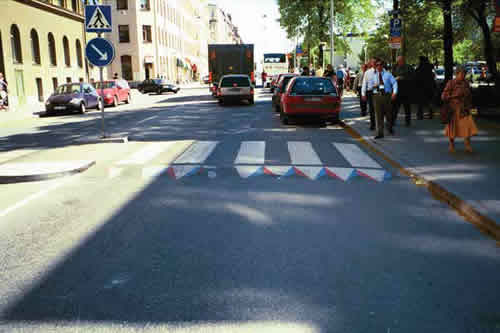






Speed bumps:
Smart speed bumps:
Speed bump, pedestrian refuge, and crosswalk:
Double refuge, speed bumps, and double crosswalk:
1 way curb extension with speed bumps:
1 way bus bulb out with speed bump:
PBOT is making slow, marginal improvements to a few dangerous areas. That’s it. Most of the city gets low-grade to useless and expensive ‘experimental pilots’ improvements.
Meanwhile, PBOT would rather die than install cheap infrastructure that actually lowers speeds.
Bull. PBOT regularly overhypes and oversells their pathetic projects. If ‘opponents’ (whatever that means) are able to kill safety projects by being louder, that just means your transportation agency is garbage. Folks shouldn’t have to come yell at the city to get things done. It’s absurd that so many people have internalized the idea that ‘squeaky wheel gets the grease’ is a good thing.
Portland’s traffic deaths per 100,000 residents:
2020 — 8.3
2010 — 4.5
PBOT’s Vision Zero project has always been an underfunded PR exercise, despite efforts of Eudaly and Hardesty to make a few meaningful changes on a shoestring budget. Meanwhile, in Fremont they used municipal revenue and grants to build the nice things we can only dream about in this SUV-centric city:
(From the linked article.)
I don’t think Fremont, CA has done the Swedish improvements.
My understanding is they did some enforcement and street lighting improvements, as well as some education and some intersection treatments. But it’s great they keep working on it.
We can dream of Danish/Swedish/Netherlands improvements and work to make them happen.
Too bad car horns don’t have a quieter tone for courtesy honks and a louder horn for emergency honks, like the orp bike horn/light.
Too bad Google Maps still shows where speed limits are being enforced (“speed traps” [sic]) to aid and abet dangerous speeders. If they were serious about supporting getting around by walking, biking, and transit, they’d stop helping dangerous drivers speed and threaten folks’ lives.
Wheeler, for all his faults, is not the primary obstacle to PBOT upping their game for bicyclists.
Your move Jo Ann Hardesty!
yeah I know that Watts. I mentioned Wheeler because the story is about a mayor.. and he’s our mayor.
This is simply not the case. Wheeler’s staff micromanages bureaus with the potential to disrupt business as usual (e.g. PBOT, BDS, and PHB) and Wheeler has threatened to take away bureau responsibilities from council members who do not toe his very conservative line.
“Courtesy honks”? No thank you!
Re: Honking
We can modify the much ridiculed Nextdoor tagline:
“When [Drivers] Start [Honking], Good Things Happen”
Why are you encouraging honking? It’s loud and sucks to hear in homes, it’s startling especially for new riders, and it gets people of using the horn more in general. I can hear a car behind me and use my mirror. Honking is impossible to know if it’s nice or not. Up close, as someone with eardrum damage, it also literally hurts. Please stop encouraging cars honking more, there’s nothing courteous about it.
Re: What people want.
The citizens’ initiative calling for a ban on private car use in central Berlin has 50,000 signatories, or about 1.6% of the adult population of the city. I’m one who would love more car free city centers, but I’m also an individual who recognizes my preferences are not close to the norm. Thus I avoid thinking of what I want as what people want. A more accurate lead might be something like ‘petitioners seek to determine whether Berliners want a car free city center’.
Honks always startle me when I’m riding. How do you interpret if they’re friendly or hostile, especially at night?
As far as the Google Maps thing: great. But can google spare a few engineers to directly engage with cities and other transpo agencies to accurately map bike lanes? It scares me how many visitors, new portlanders, or even seasoned bike users may end up on dangerous arterials without bike infra because google maps unsafely directed them to or showed them a false level of bike lanes.
Incremental reporting is an insanely unsafe and ineffective model of revising for the accuracy bike-users depend on when traveling on streets.
I can suggest several books that address the fate of the Native inhabitants of our region.
William Dietrich’s “Northwest Passage: The Great Columbia River” (1995) reminds us, among other things, that by the time Lewis & Clark arrived at the mouth of the Columbia (1805) half or more of the native population was dead from diseases introduced by European sea based traders.
Terence O’Donnell’s “An Arrow in the Earth: General Joel Palmer and the Indians of Oregon”(1991) details the various combinations of violence, deceit, and disease that cleared the path for European settlement of Oregon.
Last, Alvin Josephy’s history of the Nez Perce War of 1977, “Nez Perce Indians and the Opening of the Northwest”(1979) carefully tells the full story of the betrayal of that fine tribe (which saved Lewis & Clark in 1805) and the theft of their traditional lands, the Wallowa country.
Just a start, and there is no doubt lots of more recent scholarship on the subject.
Not trying to be a troll. But what am I supposed to be thinking about or doing with the information listed in the indigenous peoples map? This went wild on Instagram for a while and it just seems like super bogus virtue signaling. Like…what? What are you saying or doing and why? I’m biking around Portland, going to work, on land that was once home to the Multnomah people. It *is* interesting. But beyond that, what? Anytime I see someone’s bike post and they list all the tribal lands they biked through all I can ever wonder is, “I wonder if they displaced someone else. Did they take that land by force? Who was here before them? There must be unknown history here…no one sprang from the dirt, someone came before them I’d guess. Is this all “clovis land”? I’m dumb, what do I know?” Honest, not trying to be a dick. This is just something I think about.